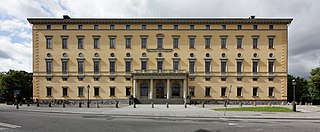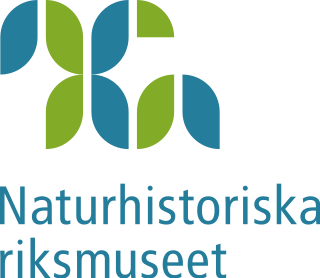
Stockholm University is a public research university in Stockholm, Sweden, founded as a college in 1878, with university status since 1960. With over 33,000 students at four different faculties: law, humanities, social sciences, and natural sciences, it is one of the largest universities in Scandinavia. The institution is regarded as one of the top 100 universities in the world by the Academic Ranking of World Universities (ARWU).

Uppsala is the county seat of Uppsala County and the fourth-largest city in Sweden, after Stockholm, Gothenburg, and Malmö. It had 177,074 inhabitants in 2019.

Uppsala University is a public research university in Uppsala, Sweden. Founded in 1477, it is the oldest university in Sweden and the Nordic countries still in operation. The university motto is "Gratiae veritas naturae".
The Royal Swedish Academy of Agriculture and Forestry, formerly the Royal Swedish Academy of Agriculture, founded in 1813 at the initiative of Crown Prince Charles, is one of the Royal Academies in Sweden. Initially the Academy had a function of being auxiliary to the central administrative authorities. The Academy now acts an independent organization, promoting agriculture, forestry and related fields with the support of science and practical experience, in the interest of Swedish society.

The Royal Swedish Academy of Letters, History and Antiquities also called simply the Royal Academy of Letters or Vitterhetsakademin abbreviated KVHAA is the Swedish royal academy for the Humanities. Its many publications include the archaeological and art historical journal Fornvännen, published since 1906.

The Swedish University of Agricultural Sciences, or Swedish Agricultural University (SLU) is a university in Sweden. Although its head office is located in Ultuna, Uppsala, the university has several campuses in different parts of Sweden, the other main facilities being Alnarp in Lomma Municipality, Skara, and Umeå. Unlike other state-owned universities in Sweden, it is funded through the budget for the Ministry for Rural Affairs. The University was co-founder of the Euroleague for Life Sciences (ELLS) which was established in 2001.

The Royal Society of Sciences in Uppsala, is the oldest of the royal academies in Sweden, having been founded in 1710. The society has, by royal decree of 1906, 50 Swedish fellows and 100 foreign.

The Archbishop of Uppsala has been the primate of Sweden in an unbroken succession since 1164, first during the Catholic era, and from the 1530s and onward under the Lutheran church.

Lars Fredrik Nilson was a Swedish chemist, professor at Uppsala University, and later Director of the Agricultural Chemical Experiment Station at the Royal Swedish Academy of Agriculture and Forestry in Stockholm.

Flogsta is a neighbourhood in the west part of the Swedish city of Uppsala. Most of its inhabitants are students attending Uppsala University or the Swedish University of Agricultural Sciences.

The Uppsala University Library at Uppsala University in Uppsala, Sweden, consists of 11 subject libraries, one of which is housed in the old main library building, Carolina Rediviva. The library holds books and periodicals, manuscripts, musical scores, pictures and maps.

The Mälaren Valley, occasionally referred to as Stockholm-Mälaren Region (Stockholm-mälarregionen), is the easternmost part of Svealand, the catchment area of Lake Mälaren and the surrounding municipalities. The term is often used interchangeably for the extended capital region of Sweden as Stockholm is located at the lake's eastern end, at its outlet in the Baltic Sea.

The Swedish Museum of Natural History, in Stockholm, is one of two major museums of natural history in Sweden, the other one being located in Gothenburg.

Frescati is a park-like area on the northern outskirts of Stockholm, Sweden. It is situated in an area on Norra Djurgårdsstaden. Frescati is part of the Royal National City Park.
The University College Stockholm, formerly the Stockholm School of Theology, is an independent school for theology and human rights in Stockholm, Sweden, sponsored by the Uniting Church in Sweden.

Göte Wilhelm Turesson was a Swedish evolutionary botanist who made significant contributions to ecological genetics, and coined the terms ecotype and agamospecies. He conducted extensive work to demonstrate that there is a genetic basis to the differentiation of plant populations. This work stood in sharp contrast to most researchers at the time, who believed that the differentiation of plant populations was due to phenotypic plasticity. Further, Turesson came to the conclusion that differentiation of plant populations was largely driven by natural selection. His work on locally adapted plant populations led him to coin the term "ecotype" in 1922.
Upsala-Lenna Järnväg (ULJ) is a narrow-gauge heritage railway in Uppsala County, Sweden. It is 33 km (21 mi) long and is a part of the once extensive Roslagen network. The gauge is the 891 mm, unique to Sweden. The railway is run by the SRJmf society.

Astrid Maria Cleve von Euler was a Swedish botanist, geologist, chemist and researcher at Uppsala University. She was the first woman in Sweden to obtain a doctoral degree of science.

Skånela Church is a medieval Lutheran church in the Archdiocese of Uppsala in Stockholm County, Sweden. It is one of the oldest churches in Stockholm County.

Arvid Gustaf Högbom was a Swedish geologist. He was a professor of mineralogy and geology at Uppsala University.

















